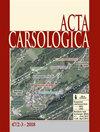斯洛文尼亚Postojna洞穴骨骼碎片和相关洞穴化石的DNA、光谱和地球化学分析
IF 1.1
4区 地球科学
Q4 GEOSCIENCES, MULTIDISCIPLINARY
引用次数: 1
摘要
从Postojna洞穴中收集了一个松散/破碎的石笋,其中含有小块胶结骨碎片,以研究是否可以确定脱氧核糖核酸(DNA)。该研究由傅里叶变换红外光谱-衰减全反射(FTIR-ATR)分析补充,以确定骨骼的变化,并测试该分析是否可以用作可能的DNA保存的指标。此外,还进行了地球化学分析,以确定相关的流石/石笋是否适合阐明骨死亡的时间和进一步的古环境分析。有机物(胶原蛋白)保存得很差。然而,我们成功地用聚合酶链反应(PCR)扩增了一个样本线粒体DNA (mtDNA)的细胞色素b (Cyt b)基因的94bp长片段,并对洞熊(Ursus deningeri或Ursus spelaeus sensu lato)的Cyt b进行了测序。对覆盖骨骼的岩石层进行铀钍定年,发现其死亡时间早于55 ka,极有可能发生在海洋同位素4期晚期或海洋同位素3期早期。洞内这部分流石/石笋的高孔隙度和重结晶影响了高分辨率的古气候解释;然而,低分辨率稳定同位素地球化学表明,在洞穴层随后的生长过程中,存在类似草原的环境。本文章由计算机程序翻译,如有差异,请以英文原文为准。
DNA, spectroscopic and geochemical analyses of bone fragments and associated speleothems in Postojna cave, Slovenia
a loose/broken stalagmite containing small fragments of cemented bones were collected from the Postojna Cave to investigate whether deoxyribonucleic acid (DNA) can be determined. The study is complemented by the Fourier-transform infrared spectroscopy - attenuated total reflectance (FTIR-ATR) analysis in order to determine the alteration of the bones and to test whether this analysis can be used as an indicator of possible DNA preservation. In addition, geochemical analyses were conducted in order to determine whether the associated flowstone/stalagmite is suitable for elucidating the timing of bone thanatocoenosis and further palaeoenvironmental analyses. The organic matter (collagen) is poorly preserved. However, we succeeded in amplifying a 94 bp long fragment of the cytochrome b (Cyt b) gene of mitochondrial DNA (mtDNA) in polymerase chain reaction (PCR) for one sample, and in sequencing the amto that of the Cyt b of the cave bear (Ursus deningeri or Ursus spelaeus sensu lato). The uranium-thorium dating of the speleothem covering the bones revealed its thanatocoenosis occurred prior to 55 ka, most likely in the late marine isotope stage 4 or early marine isotope stage 3. High porosity and recrystallisation of the flowstone/stalagmite at this part of the cave prevent high-resolution palaeoclimatic interpretation; however, low-resolution stable isotope geochemistry suggests a steppe-like environment during the subsequent growth of the speleothem.
求助全文
通过发布文献求助,成功后即可免费获取论文全文。
去求助
来源期刊

Acta Carsologica
地学-地球科学综合
CiteScore
1.50
自引率
14.30%
发文量
0
审稿时长
>12 weeks
期刊介绍:
Karst areas occupy 10-20 % of ice-free land. Dissolution of rock by natural waters has given rise to specific landscape and underground. Karst surface features and caves have attracted man''s curiosity since the dawn of humanity and have been a focus to scientific studies since more than half of millennia.
Acta Carsologica publishes original research papers and reviews, letters, essays and reports covering topics related to specific of karst areas. These comprise, but are not limited to karst geology, hydrology, and geomorphology, speleology, hydrogeology, biospeleology and history of karst science.
 求助内容:
求助内容: 应助结果提醒方式:
应助结果提醒方式:


